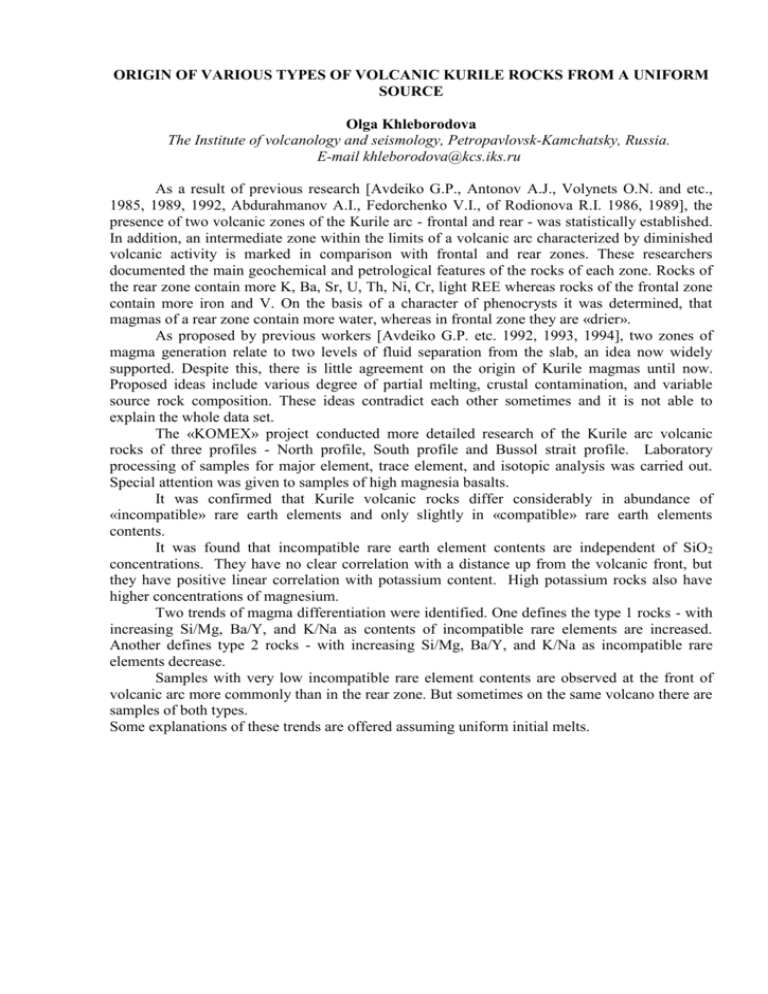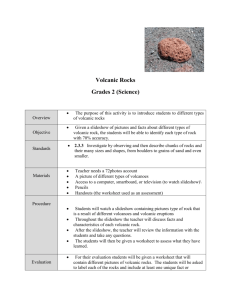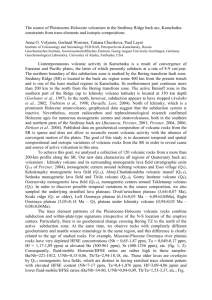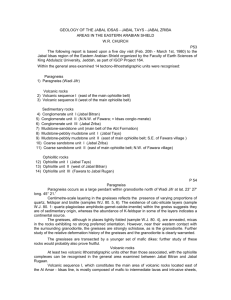origin of various types of volcanic kurile rocks from a uniform source
advertisement

ORIGIN OF VARIOUS TYPES OF VOLCANIC KURILE ROCKS FROM A UNIFORM SOURCE Olga Khleborodova The Institute of volcanology and seismology, Petropavlovsk-Kamchatsky, Russia. E-mail khleborodova@kcs.iks.ru As a result of previous research [Avdeiko G.P., Antonov A.J., Volynets O.N. and etc., 1985, 1989, 1992, Abdurahmanov A.I., Fedorchenko V.I., of Rodionova R.I. 1986, 1989], the presence of two volcanic zones of the Kurile arc - frontal and rear - was statistically established. In addition, an intermediate zone within the limits of a volcanic arc characterized by diminished volcanic activity is marked in comparison with frontal and rear zones. These researchers documented the main geochemical and petrological features of the rocks of each zone. Rocks of the rear zone contain more K, Ba, Sr, U, Th, Ni, Cr, light REE whereas rocks of the frontal zone contain more iron and V. On the basis of a character of phenocrysts it was determined, that magmas of a rear zone contain more water, whereas in frontal zone they are «drier». As proposed by previous workers [Avdeiko G.P. etc. 1992, 1993, 1994], two zones of magma generation relate to two levels of fluid separation from the slab, an idea now widely supported. Despite this, there is little agreement on the origin of Kurile magmas until now. Proposed ideas include various degree of partial melting, crustal contamination, and variable source rock composition. These ideas contradict each other sometimes and it is not able to explain the whole data set. The «KOMEX» project conducted more detailed research of the Kurile arc volcanic rocks of three profiles - North profile, South profile and Bussol strait profile. Laboratory processing of samples for major element, trace element, and isotopic analysis was carried out. Special attention was given to samples of high magnesia basalts. It was confirmed that Kurile volcanic rocks differ considerably in abundance of «incompatible» rare earth elements and only slightly in «compatible» rare earth elements contents. It was found that incompatible rare earth element contents are independent of SiO2 concentrations. They have no clear correlation with a distance up from the volcanic front, but they have positive linear correlation with potassium content. High potassium rocks also have higher concentrations of magnesium. Two trends of magma differentiation were identified. One defines the type 1 rocks - with increasing Si/Mg, Ba/Y, and K/Na as contents of incompatible rare elements are increased. Another defines type 2 rocks - with increasing Si/Mg, Ba/Y, and K/Na as incompatible rare elements decrease. Samples with very low incompatible rare element contents are observed at the front of volcanic arc more commonly than in the rear zone. But sometimes on the same volcano there are samples of both types. Some explanations of these trends are offered assuming uniform initial melts.








